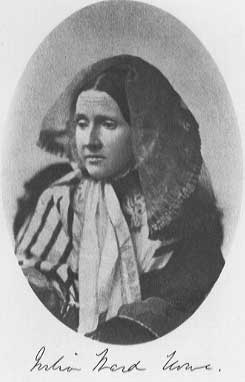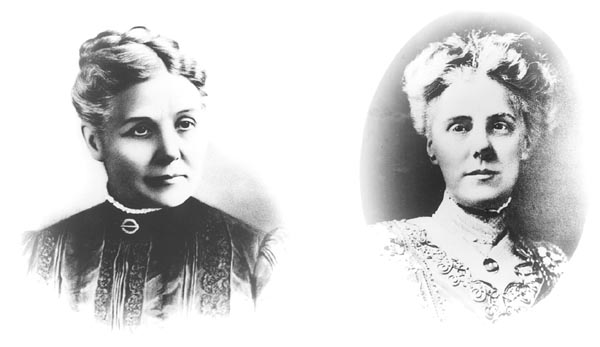- Mother's Day has a lot of distant antecedents which were more religious in nature, springing first from festivals honoring Mary the mother of Jesus. With the passing of centuries and the changes in religious practice, those celebrations became more secularized or faded out.
- Then in 1872, Julia Ward Howe, who wrote the words to the "Battle Hymn of the Republic," suggested an International Mother's Day.

Julia Ward Howe. Poet, lyricist, peace activist. A woman sick of war.
(Photo from Mother's Day Central)
- The Civil War had ended only 5 years previously, but she had witnessed enough carnage and sons killing sons. Her goal, in holding an International Mother's Day, was not to honor mothers with gifts but to bring them together in a united stand against war, in favor of peace.
- She wrote an impassioned plea asking mothers to unite for this cause in a document called the Mother's Day Proclamation.
- She wanted June 2 to be established as Mother's Peace Day, and she held the first meeting in Boston on June 2, 1873. Similar meetings were held that year in 17 other cities in the United States.
- As the years passed, her Mother's Peace Day grew in popularity and more and more mothers attended each year.
- One of the women who attended one of Ward Howe's Mother's Peace Days was named Anna Marie Reeves Jarvis. She had a daughter named Anna Jarvis.
- When Reeves Jarvis died in 1905, her daughter Anna went to a couple churches where her mother had taught or where her family lived and asked them to hold memorial services in honor of her mother and all mothers everywhere.

Anna Marie Reeves Jarvis and her daughter Anna
(Photo from West Virginia Archives & History)
- Jarvis sent white carnations, which were her mother's favorite flower, in honor of her mother. Two carnations were given to every person who attended the services.
- Jarvis envisioned it as a day of prayer and thanksgiving. She wanted people all over the country to come together to offer prayers of thanks and respect for their mothers and mothers everywhere.
- Her idea did catch on. By 1911, only six years later, nearly every state in the country was having some form of a Mother's Day celebration. But most of the local celebrations had lost their religious connection.
- No one says whether she got the idea to do this from the Mother's Peace Day meetings that her mother attended. But Jarvis's Mother's Day rose in popularity while Ward Howe's Peace Day waned.
- Jarvis and many of her supporters continued to petition politicians to declare one day of the year an official Mother's Day. On May 8, 1914, President Woodrow Wilson signed a resolution establishing that Mother's Day should be celebrated every year on the second Sunday in May.
- Although her original Mother's Day service included carnations, she never intended that flowers should become a commercial item connected with the day. In fact, at one Mother's Day festival in 1930, Anna Jarvis was arrested for trying to stop women from selling flowers. She said, "I wanted it to be a day of sentiment, not profit."
Anna Jarvis, probably around the time she started to dislike the way in which people were celebrating Mother's Day.
(Photo from The Parenting Magazine)
- She was so adamant that the day not become commercialized, she tried to sue to stop one Mother's Day celebration that she thought was particularly commercial. She petitioned against a postage stamp using her mother's picture with white carnations and the words "Mother's Day" on it.
- She tried to secure copyright the phrase "Mother's Day" so she could guard against its use in applications that she thought too commercial, but too late.
- She died, blind and destitute, in 1948. She had no children so no one held a memorial celebration for her as their mother. It was the Florist's Exchange who paid for her burial.
- Today, Mother's Day weekend is the busiest of the year for florists.
- People spend about $2 billion on flowers for Mother's Day.

$2 billion in flowers is a whole lot of flowers. This is a photo of how flowers are sold at the flower auction markets in Holland.
(Photo from Bunches.co.uk)
- All told, in 2006, gifts for Mother's Day (flowers, jewelry, clothing, greeting cards, trips to spas, dinners out, gift certificates, gardening tools, books and electronics) totaled about $14 billion.
All right, so that's the story of Mother's Day. It reads like a frowny-faced tale of a good thing turned commercial and therefore bad, and the moral is you should feel guilty for buying your mom a present because that means you're just feeding the commercial machine. Well, I don't think that moral does anybody any good. For one thing, that gets out of telling your mom, hey, thanks for giving birth to me and feeding me and loving me and and taking care of me and putting up with me for all those years.
Besides, a lot of stories of our holidays in this country have endings like that. They start out as religious festivals of some kind, get secularized, and now there's a whole bunch of money tied up in them. I'm thinking that might be the story of our country. The fact that something has a whole bunch of people and money involved might be the way our country says: success!
Maybe the way to think of this story of Mother's Day is not as some good romanticized thing gone money-choked and bad, but as a success story. This was one woman's wish that her mother and all mothers be honored for all that they do for us. She worked really hard to get her idea to catch on and to be acted upon throughout the whole country, and it's happening. Still. Nearly 100 years later, we're still doing it. Maybe not exactly in the way she wanted, but we are still saying to our mothers every year, "Thanks, Mom. I love you." And we're doing it while they're still alive.

Here's one way to say I love you, Mom.
(This is actually a free screensaver from T&P SC)

Here's another.
(Photo from malcolmxpark.org)
I can't resist, though, adding some of Julia Ward Howe's words to mothers. Because I think her words still apply today. Being a mom isn't just about love and happy thoughts. It's about hard work and hard choices made to look after the ones they love, especially when there's bad cess like war going on. Say it for us, Julia:
Arise then...women of this day!
Arise, all women who have hearts!
Whether your baptism be of water or of tears!
Say firmly:
"We will not have questions answered by irrelevant agencies,
Our husbands will not come to us, reeking with carnage,
For caresses and applause.
Our sons shall not be taken from us to unlearn
All that we have been able to teach them of charity, mercy and patience.
We, the women of one country,
Will be too tender of those of another country
To allow our sons to be trained to injure theirs."
Here's to mothers everywhere who have fought to give us the good things, the important things.

A Peace Rose, with thanks, to Mom.
(Photo from Liberty Art Works)
Sources
Society for the Confluence of Festivals in India, Mother's Day
Chiff.com, Mother's Day Proclamation of 1870: Mother's Peace Day, The Origins of Mother's Day
Mother's Day Central, Mother's Day History
Jone Johnson Lewis, "Mother's Day History," About.com
A lovely post to celebrate the day. www.satisfiedsole.com
ReplyDeletenice one
ReplyDeleteMothers Day 2018 Wishes
It is my first time I visit here. I found so many entertaining stuff in your blog, especially its discussion.
ReplyDeletebest homeopathy doctor in India